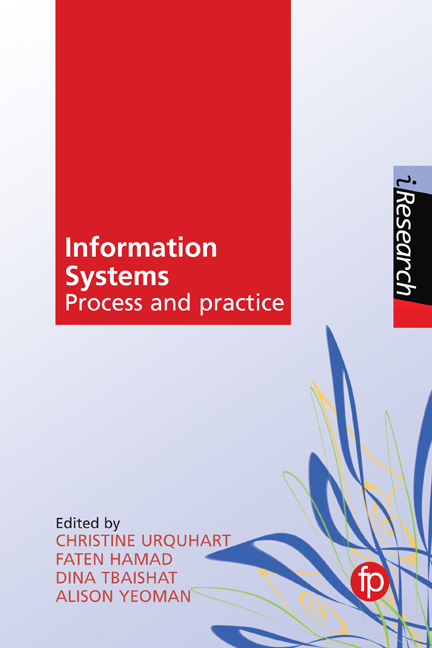Book contents
- Frontmatter
- Contents
- List of tables and figures
- Series editor's foreword
- About the authors
- 1 Introduction
- 2 Approaches to information architecture
- 3 Taxonomy testing for information architecture
- 4 The enterprise website and its information structures
- 5 Analysing activities, roles and processes
- 6 Libraries and the organisation of library processes – a history of operational research, and the use of process modelling
- 7 Using Riva process modelling to study book acquisition in academic libraries
- 8 Workflow analysis and process mapping in US academic libraries
- 9 A theoretical framework for designing and evaluating semi-structured document triage interfaces
- 10 Resource discovery case studies
- 11 Increasing social connection through a community-of-practice-inspired design
- 12 Methods for studying information provision, networking and communication in patient support groups
- 13 Health information systems: clinical data capture and document architecture
- 14 Producing systematic reviews and getting evidence to the clinician
- Index
7 - Using Riva process modelling to study book acquisition in academic libraries
Published online by Cambridge University Press: 08 June 2018
- Frontmatter
- Contents
- List of tables and figures
- Series editor's foreword
- About the authors
- 1 Introduction
- 2 Approaches to information architecture
- 3 Taxonomy testing for information architecture
- 4 The enterprise website and its information structures
- 5 Analysing activities, roles and processes
- 6 Libraries and the organisation of library processes – a history of operational research, and the use of process modelling
- 7 Using Riva process modelling to study book acquisition in academic libraries
- 8 Workflow analysis and process mapping in US academic libraries
- 9 A theoretical framework for designing and evaluating semi-structured document triage interfaces
- 10 Resource discovery case studies
- 11 Increasing social connection through a community-of-practice-inspired design
- 12 Methods for studying information provision, networking and communication in patient support groups
- 13 Health information systems: clinical data capture and document architecture
- 14 Producing systematic reviews and getting evidence to the clinician
- Index
Summary
COMMENTARY: CHRISTINE URQUHART
This chapter uses the example of processes involved in book acquisitions to illustrate how Riva process modelling techniques for role activity diagrams are applied. As Chapter 5 demonstrated, there are other ways of looking at what is done in a set of activities that belong together to achieve some purpose. Chapter 5 examines use case descriptions and use case diagrams. Many readers will be familiar with simple flow diagrams where the diamonds indicate decision points. Flowcharts are perfectly effective, but for complicated situations many sheets are required. Many years ago, I remember an assignment received from a distance learning student working in a government department where the flowchart for the decision processes involved in deciding on the amount of money to be awarded to a claimant spread over many pages. The role activity diagramming, in contrast, is much neater and much easier for the analyst and members of staff involved in the roles presented to discuss. The decision points are clearly marked and, quite important, the activities that can take place in parallel are displayed.
The chapter outlines some of the business process modelling work that has taken place in libraries; it seems that there is little in the published literature. Research work suggests that the work is often done, but casually, and the work stored as flowcharts in desk drawers, or possibly attached to procedure manuals. Perhaps such work is not deemed suitable for publication – just task-based guidelines that only apply, it is assumed, to one library and information service. Perhaps there is a feeling that it should not be possible to decompose professional work, that there is judgement and expertise involved that cannot be expressed in the black and white of an activity diagram or flowchart. The professional librarian's work at the enquiry desk cannot be reduced to the scripts followed by call centre staff. Or can it? While librarians and information professionals do not fall wholly into the professional groups that strictly control the acquisition and application of various kinds of knowledge, as information professionals we are known to vaunt expertise in information literacy, for example, or information retrieval (see Chapter 14, on searching for systematic reviews).
- Type
- Chapter
- Information
- Information SystemsProcess and Practice, pp. 107 - 126Publisher: FacetPrint publication year: 2017



